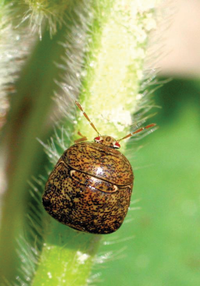
Like the boll weevil in the late 19th century, the kudzu bug has found a home in the U.S., quickly spreading across much of the South, and with few natural enemies, entomologists say it’s likely to be around a long time.
But unlike the crop-ravaging, difficult-to-control boll weevil, the kudzu bug (bean plataspid/Megacopta cribraria Fabricius) can be easily controlled with available pesticides, and crop damage can be kept to a minimum.
The challenge for Mississippi soybean growers, says Angus Catchot, is educational — to “keep farmers from freaking out when they see large numbers of kudzu bugs in their fields and immediately start spraying.”
RELATED: Kudzu bug: Increasingly a pest in southern soybeans

ADULT MALE kudzu bug on a soybean plant. (University of Delaware photo)
That could be a mistake, says Catchot, Extension entomology professor at Mississippi State University, because it could cause flaring of other more harmful insects and necessitate multiple applications when one would have been sufficient.
“Keep in mind that it takes tremendous numbers of these pests, over time, to cause yield loss,” he said at the annual meeting of the Mississippi Agricultural Consultants Association at Mississippi State University. “You’re not going to be penalized by waiting until the optimum time to spray. Wait until adults have finished migrating into the field and nymphs appear before you spray.”
Ag news delivered daily to your inbox: Subscribe to Delta Farm Press Daily.
There are two big migrations each year, one in the spring, another in the fall, Catchot says. “Adult kudzu bugs can migrate into fields for four to six weeks, and spraying too early can be ineffective because later-arriving insects will reinfest the field.”
When scouting, he says, “Once you start picking up immature kudzu bugs in your sweep net, that’s a good sign the adult migration is over, and one well-timed spray should do the job. The challenge is to not panic and spray too early, getting yourself into a two- or three-spray situation when, by waiting, you could’ve made only one.
Risk flaring other pests
“If you spray too soon, you’ll keep spraying, because they’ll keep coming. We don’t want to create a problem by spraying for really low numbers and risk flaring bollworms, loopers, and other pests.
“Our recommendation is to hold off making an insecticide application until you find one kudzu bug nymph per sweep, or 5 adults per plant during vegetative stages.
“Pyrethroids work well to control this pest,” Catchot says. “I really don’t think it’s going to be a hard pest to deal with.”
SEE ALSO: 'Incredible' new diamide chemistry needs stewardship to avoid resistance
And, he says, Mid-South growers have the benefit of extensive grower/research experience in Georgia, where kudzu bugs were found in 2009. From there, they have been “spreading at an exponential rate. It’s unbelievable how rapidly this pest reproduces.
“Three years later, in 2012, it was found in four counties in Mississippi, and it continues moving super-fast. Tom Allen [associate Extension/research professor at the Delta Research and Extension Center] has done a lot of work in documenting the spread of this pest as he traveled around the state examining kudzu for Asian soybean rust.
“We sprayed about 2,500 acres last year south of Interstate Highway 20, and I expect this is going to be the norm for growers in a few years.”
While feeding by kudzu bugs can damage soybean plants, Catchot says “it takes an awful lot of them to do it. They don’t feed on the pods, but prefer to feed on petioles and stems. They cause yield loss by sucking the overall vigor of the plant.”
Unlike most pests that are only a problem in crop fields, he says kudzu bugs can also be a significant problem for homeowners, public buildings, etc.
“In massive numbers, they’re hard to deal with in those situations. And they stink. In the Southeast, they’ve shut down convention centers, churches, and other public places.”
In such situations, entomologists recommend proactive measures — sealing cracks and other entry points to keep the bugs out — rather than insecticide use.
Stay current on what's happening in Mid-South agriculture: Subscribe to Delta Farm Press Daily.
About the Author(s)
You May Also Like




